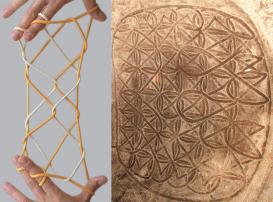This project compares, through an ethnomathematical approach, two activities carried out by the Northern Ambrym Islanders (Republic of Vanuatu), both of which are locally termed tu (lit. "to write"). These practices consist in making a figure, either with a loop of string ("string figure-making," using the fingers and sometimes the feet and the mouth) or by drawing a continuous line in the sand with one finger ("sand drawing"). My comparative research first analyzes the shared and exclusive mathematical properties of these two procedural activities, by focusing on concepts such as operation, algorithm, sub-procedure, iteration, and transformation. Since the two practices are both means of recording and expressing knowledge relating to particular mythological entities or cosmological and environmental elements in Northern Ambrym society, the analysis also focuses on the links between the procedures involved in the making of these figures and particular forms of memory and tradition embedded in such practices. The project thus aims for a better understanding of how Ambrymese practitioners proceed to create these complex string figure and sand drawing algorithms—"making them work"—while combining different forms of knowledge in the artefacts. It also contributes to defining the criteria for identifying "mathematical practices" in the cultural context of oral tradition, an issue at the core of ethnomathematics.

